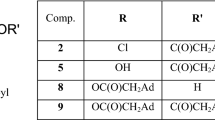Abstract
Purpose: ET-18-OCH3 (1-O-octadecyl-2-O-methyl-rac-glycero-3-phosphocholine) is a representative of the first generation of antitumor ether lipids and is a model in the development of new compounds including a series of quaternary ammonium analogs (QAA). In the present study, we evaluated the QAA as inhibitors of cell growth and studied their mechanism of action. Methods: We compared the effects of the QAA on the proliferation of human leukemia cell lines which are sensitive (HL-60) or resistant to ET-18-OCH3 (HL-60R and K562). In addition we used cell fractionation and enzymatic assays to determine the effects of QAA on protein kinase C (PKC) translocation in response to 12-O-tetradecanoyl-phorbol-13-acetate (TPA). Results: The QAA and ET-18-OCH3 were approximately equally effective inhibitors of HL-60 cell growth. However, the QAA were more effective inhibitors of K562 and HL-60R cell proliferation. The HL-60R cells, which were selected for resistance to ET-18-OCH3, were also resistant to BM 41.440 which is structurally similar. In serum-free medium, the phosphorus-containing compounds (ET-18-OCH3, BM 41.440 and He-PC) were much more effective inhibitors (8–20-fold) of the K562 cell line while the activities of the QAA were only moderately increased (1.2–2.3-fold). When serum albumin was added to the serum-free medium, the K562 cells became resistant to ET-18-OCH3, suggesting that albumin is responsible for the differential sensitivity. The QAA compounds, which inhibit PKC activity in vitro, inhibited cell proliferation. However, a QAA which did not inhibit PKC did not inhibit cell proliferation. The phorbol ester TPA stimulates PKC translocation and causes HL-60 cell differentiation to adherent macrophage-type cells. The QAA inhibited TPA-induced cell differentiation and PKC translocation indicating that they also inhibit PKC in intact cells. Conclusions: The cellular effects of the QAA appear to be due to inhibition of PKC. In addition, these data indicate that albumin, which is important as a mediator of the uptake of ET-18-OCH3, has only a small effect on the uptake of QAA. Together these data indicate that the QAA are potential anticancer agents, showing a significant ability to inhibit growth of leukemia cell lines that are resistant to ET-18-OCH3.
Similar content being viewed by others
Author information
Authors and Affiliations
Additional information
Received: 1 July 1997 / Accepted: 25 November 1997
Rights and permissions
About this article
Cite this article
Civoli, F., Daniel, L. Quaternary ammonium analogs of ether lipids inhibit the activation of protein kinase C and the growth of human leukemia cell lines. Cancer Chemother Pharmacol 42, 319–326 (1998). https://doi.org/10.1007/s002800050824
Issue Date:
DOI: https://doi.org/10.1007/s002800050824




